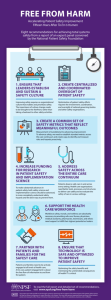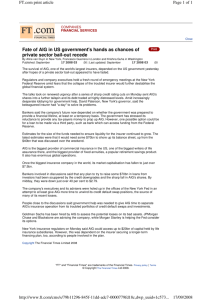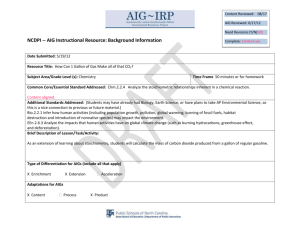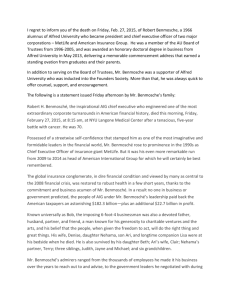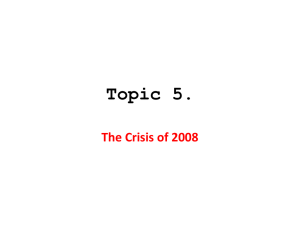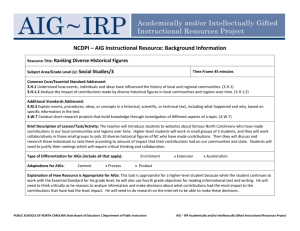AIG and Credit Default Swaps
advertisement
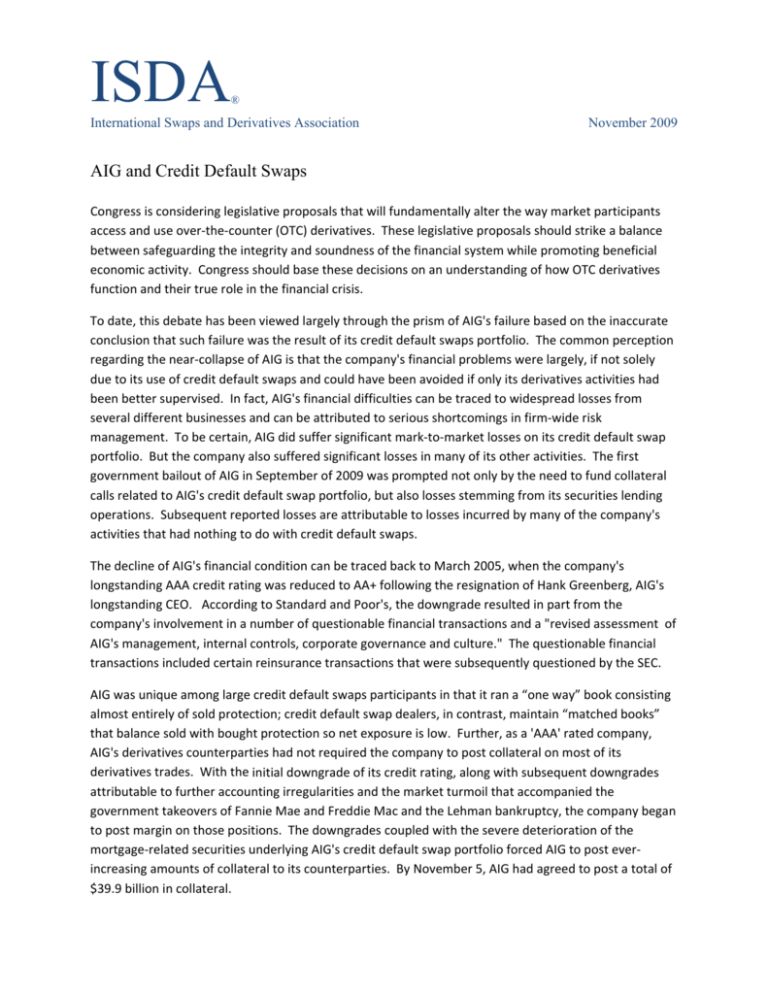
ISDA ® International Swaps and Derivatives Association November 2009 AIG and Credit Default Swaps Congress is considering legislative proposals that will fundamentally alter the way market participants access and use over‐the‐counter (OTC) derivatives. These legislative proposals should strike a balance between safeguarding the integrity and soundness of the financial system while promoting beneficial economic activity. Congress should base these decisions on an understanding of how OTC derivatives function and their true role in the financial crisis. To date, this debate has been viewed largely through the prism of AIG's failure based on the inaccurate conclusion that such failure was the result of its credit default swaps portfolio. The common perception regarding the near‐collapse of AIG is that the company's financial problems were largely, if not solely due to its use of credit default swaps and could have been avoided if only its derivatives activities had been better supervised. In fact, AIG's financial difficulties can be traced to widespread losses from several different businesses and can be attributed to serious shortcomings in firm‐wide risk management. To be certain, AIG did suffer significant mark‐to‐market losses on its credit default swap portfolio. But the company also suffered significant losses in many of its other activities. The first government bailout of AIG in September of 2009 was prompted not only by the need to fund collateral calls related to AIG's credit default swap portfolio, but also losses stemming from its securities lending operations. Subsequent reported losses are attributable to losses incurred by many of the company's activities that had nothing to do with credit default swaps. The decline of AIG's financial condition can be traced back to March 2005, when the company's longstanding AAA credit rating was reduced to AA+ following the resignation of Hank Greenberg, AIG's longstanding CEO. According to Standard and Poor's, the downgrade resulted in part from the company's involvement in a number of questionable financial transactions and a "revised assessment of AIG's management, internal controls, corporate governance and culture." The questionable financial transactions included certain reinsurance transactions that were subsequently questioned by the SEC. AIG was unique among large credit default swaps participants in that it ran a “one way” book consisting almost entirely of sold protection; credit default swap dealers, in contrast, maintain “matched books” that balance sold with bought protection so net exposure is low. Further, as a 'AAA' rated company, AIG's derivatives counterparties had not required the company to post collateral on most of its derivatives trades. With the initial downgrade of its credit rating, along with subsequent downgrades attributable to further accounting irregularities and the market turmoil that accompanied the government takeovers of Fannie Mae and Freddie Mac and the Lehman bankruptcy, the company began to post margin on those positions. The downgrades coupled with the severe deterioration of the mortgage‐related securities underlying AIG's credit default swap portfolio forced AIG to post ever‐ increasing amounts of collateral to its counterparties. By November 5, AIG had agreed to post a total of $39.9 billion in collateral. P a g e | 2 The liquidity strains caused by margin calls against the credit default swaps portfolio was amplified by liquidity strains arising from AIG's securities lending unit. Under AIG's securities lending program, borrowers posted cash collateral with AIG in exchange for loans of securities owned by the company's insurance company subsidiaries. As of the end of August 2008, AIG's US securities lending program had approximately $69 billion of borrowings outstanding. Normally, the lender (i.e., AIG) would invest collateral received in highly liquid and safe short‐term securities such as Treasury bills to earn a modest return. AIG, however, invested the collateral it received in subprime mortgage backed securities. As borrowers began returning the securities they had borrowed and demanding repayment of collateral. AIG found it could not sell the mortgage‐backed securities in which it had invested the cash collateral and had to search for alternative sources of funds. By November 2008, the company was almost entirely dependent on the Federal Reserve and the Treasury for funding. According to Federal Reserve data, AIG had borrowed a total of almost $128 billion by the end of the year. $40 billion from a bridge loan designed to help the company continue operating while it sells off non‐core assets; $28 billion to purchase the collateralized debt obligations on which AIGFP had sold protection. $20 billion of the $22.5 billion allotted to purchase subprime mortgage backed securities in which AIG had invested as part of its securities lending program (note: these are not the only mortgage backed securities in which AIG invested); and $40 billion capital investment through the TARP program. As these figures show, most of the federal "bailout" funds were directed at enabling the company to continue to fund its activities and not directly related to losses incurred in connection with AIG's credit default swaps. AIG chose to make a bad investment decision to expose itself to mortgages that went sour. The acute liquidity crunch, triggered by AIG's credit rating downgrade, that ultimately led to AIG's bailout is attributable to AIG's failure to assess the risks of MBS, CDOs and other mortgage market exposures. Apparently, AIG relied excessively on a credit risk model that did not adequately account for both the sharp decline in the mortgage market and a downgrade of AIG's credit rating. It has been said that AIG would never have needed government assistance if not for its investments in credit default swaps. Perhaps that is true. But it would be more accurate to state that AIG would never have needed government assistance if had not so heavily exposed itself to mortgage backed securities.
